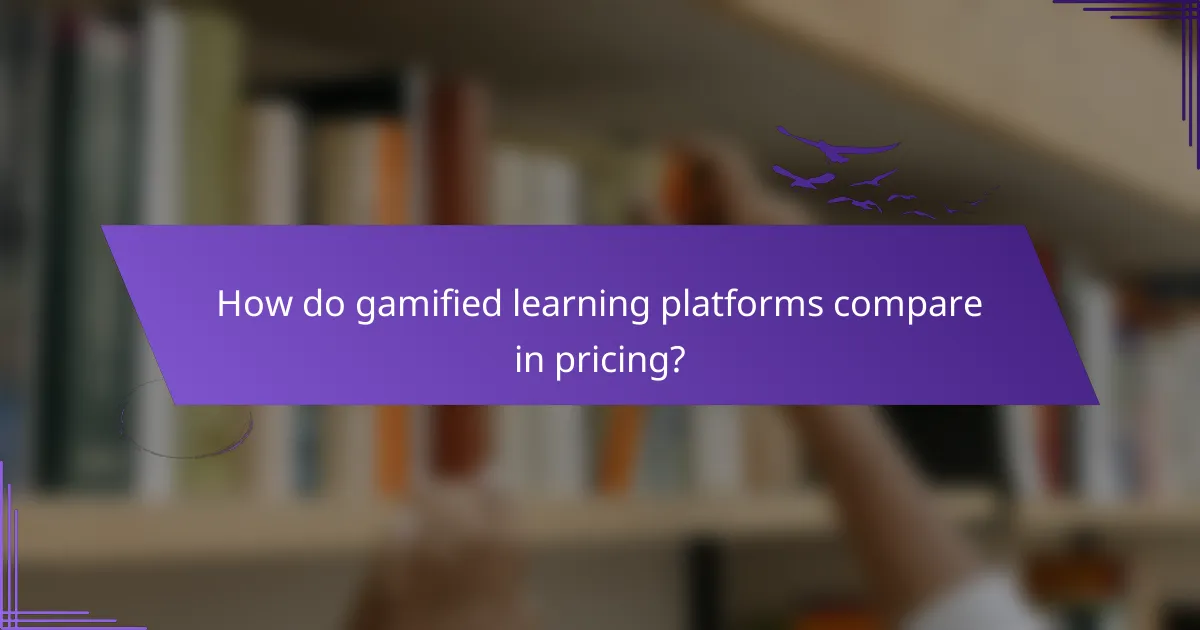Gamified learning platforms are revolutionizing online education by integrating game-like elements that boost student engagement and motivation. Platforms such as Kahoot!, Classcraft, Edmodo, and Quizlet each offer distinct features that enhance interactive learning experiences. To assess their effectiveness, key metrics like user engagement, learning outcomes, and time spent on the platform are essential for understanding their impact on educational success.

What are the best gamified learning platforms for online courses?
The best gamified learning platforms for online courses include Kahoot!, Classcraft, Edmodo, and Quizlet. Each platform offers unique features that enhance engagement and facilitate interactive learning experiences.
Kahoot! features interactive quizzes
Kahoot! is known for its engaging quizzes that allow educators to create fun, competitive learning environments. Users can design quizzes that students answer in real-time, fostering collaboration and excitement.
Consider using Kahoot! for formative assessments or review sessions. Its user-friendly interface makes it easy to create and share quizzes, and the instant feedback helps learners identify areas for improvement.
Classcraft enhances engagement through role-playing
Classcraft transforms the learning experience by incorporating role-playing elements, allowing students to create avatars and embark on quests. This approach promotes teamwork and motivation, as students can earn rewards for their participation and achievements.
To maximize Classcraft’s potential, integrate it into your curriculum by aligning quests with educational objectives. This platform is particularly effective in classrooms where collaboration and social interaction are key to learning.
Edmodo offers a collaborative learning environment
Edmodo serves as a social learning platform that connects students and teachers in a collaborative space. It allows users to share resources, assignments, and feedback, fostering a community of learners.
Utilize Edmodo to facilitate discussions and group projects, enhancing peer-to-peer interaction. Its features, such as polls and quizzes, can help gauge student understanding and encourage participation.
Quizlet enables flashcards and games for study
Quizlet provides tools for creating flashcards and interactive games, making studying more engaging. Students can use these resources to reinforce their knowledge through various learning modes, such as matching games and practice tests.
To effectively use Quizlet, encourage students to create their own study sets based on course material. This not only aids retention but also empowers learners to take charge of their study habits.

How do gamified learning platforms improve student engagement?
Gamified learning platforms enhance student engagement by incorporating game-like elements that motivate learners to participate actively. These platforms leverage rewards, challenges, and interactive features to create an immersive educational experience that keeps students interested and invested in their learning journey.
Increased motivation through rewards
Rewards are a fundamental aspect of gamified learning, providing students with tangible incentives to complete tasks and achieve goals. These rewards can range from points and badges to real-world prizes, fostering a sense of accomplishment and encouraging continued participation.
For example, platforms may offer digital badges for completing modules or leaderboard rankings that showcase top performers. This competitive element can drive students to engage more deeply with the content, as they seek to improve their standing and earn recognition.
Interactive elements foster active participation
Interactive features such as quizzes, simulations, and collaborative tasks promote active participation among students. By engaging learners in hands-on activities, these platforms help maintain attention and encourage critical thinking.
Incorporating elements like peer challenges or group projects can further enhance interaction, allowing students to collaborate and learn from one another. This social aspect not only boosts engagement but also builds a sense of community within the learning environment.

What metrics should be used to evaluate gamified learning platforms?
To effectively evaluate gamified learning platforms, key metrics include user engagement, learning outcomes, and time spent on the platform. These metrics provide insights into how well users are interacting with the content and achieving their educational goals.
Completion rates indicate user engagement
Completion rates are a direct measure of user engagement on gamified learning platforms. High completion rates suggest that users find the content compelling and are motivated to finish the courses or modules offered.
To assess completion rates, track the percentage of users who finish a course compared to those who started it. A completion rate above 70% is generally considered strong, while rates below 50% may indicate issues with content or user motivation.
Assessment scores reflect learning outcomes
Assessment scores provide a clear indication of the learning outcomes achieved by users on gamified platforms. These scores can help determine if the educational objectives are being met and if users are retaining the information presented.
When evaluating assessment scores, consider the average scores across users and the distribution of scores. A significant number of users scoring below a certain threshold, such as 60%, may highlight areas where the content needs improvement or where additional support is necessary.
Time spent on platform measures engagement
Time spent on the platform is a critical metric for measuring user engagement. Longer time spent can indicate that users are actively interacting with the content, while very short sessions may suggest a lack of interest or difficulty in navigating the platform.
To analyze this metric, track average session duration and total time spent per user over a defined period. Aim for an average session duration of at least 15-30 minutes, as this typically indicates meaningful engagement with the learning material.

How do gamified learning platforms compare in pricing?
Gamified learning platforms vary significantly in pricing, with options ranging from free access to premium subscriptions. Understanding the pricing structures of popular platforms can help educators choose the best fit for their needs and budget.
Kahoot! offers free and premium plans
Kahoot! provides a free version that allows users to create quizzes and games, making it accessible for educators and students alike. For those seeking advanced features, such as detailed reports and enhanced customization, premium plans are available, typically ranging from around $3 to $20 per month, depending on the level of service.
When considering Kahoot!, think about your specific needs. If you only require basic functionalities, the free version may suffice. However, if you want to track student progress or access a larger question bank, investing in a premium plan could be worthwhile.
Classcraft pricing varies by features
Classcraft offers a tiered pricing model based on the features selected. The basic version is free and includes essential gamification tools, while premium plans can cost between $10 to $20 per month per teacher, depending on the features desired, such as advanced analytics and customization options.
When evaluating Classcraft, consider how many features you need. The free version is a good starting point, but if you plan to implement gamification extensively, the premium options may provide valuable tools for engagement and tracking.
Edmodo provides free access with optional upgrades
Edmodo is primarily free for users, offering a platform for collaboration and communication among students and teachers. However, it also provides optional upgrades for additional features, which can enhance the learning experience but may come at a cost of around $10 to $15 per month.
For educators using Edmodo, the free access is a strong advantage, especially for those in budget-conscious environments. If you find the need for more sophisticated tools, consider the optional upgrades, but assess whether the additional features align with your educational goals before committing financially.

What are the prerequisites for developing a gamified learning platform?
Developing a gamified learning platform requires a clear understanding of user needs and solid technical expertise in software development. These prerequisites ensure that the platform is engaging, effective, and technically sound.
Understanding user needs is essential
Identifying the target audience and their learning preferences is crucial for creating an effective gamified learning platform. Conduct surveys, interviews, or focus groups to gather insights about what motivates users and how they prefer to learn.
Consider factors such as age, educational background, and technological proficiency. Tailoring the platform’s features to meet these needs can significantly enhance user engagement and satisfaction.
Technical expertise in software development is required
A strong foundation in software development is necessary to build a robust gamified learning platform. This includes knowledge of programming languages, database management, and user interface design, which are essential for creating an interactive and user-friendly experience.
Additionally, familiarity with game mechanics and educational theories can help in designing effective learning activities. Collaborating with experienced developers or using established frameworks can streamline the development process and improve the final product.

What are the emerging trends in gamified learning platform development?
Emerging trends in gamified learning platform development focus on enhancing user engagement and educational outcomes through innovative technologies. Key trends include the integration of artificial intelligence for personalized learning and the use of virtual reality to create immersive educational experiences.
Integration of AI for personalized learning experiences
Integrating AI into gamified learning platforms allows for tailored educational experiences that adapt to individual learner needs. AI algorithms analyze user performance and preferences, adjusting content and challenges accordingly to optimize learning paths.
For instance, platforms can utilize AI to recommend specific modules based on a learner’s strengths and weaknesses, ensuring that users remain engaged and challenged. This personalization can lead to improved retention rates and overall satisfaction.
When implementing AI, consider the balance between automation and human oversight. While AI can enhance learning, it’s essential to maintain a human element for support and motivation, avoiding over-reliance on technology.
Use of VR for immersive educational environments
Virtual reality (VR) is revolutionizing gamified learning by providing immersive environments that enhance engagement and retention. VR allows learners to interact with educational content in a three-dimensional space, making complex concepts more tangible and easier to understand.
For example, in a science class, students can explore the human body in VR, experiencing anatomy firsthand rather than through traditional textbooks. This hands-on approach can significantly improve comprehension and interest in the subject matter.
When incorporating VR, ensure that the technology is accessible and user-friendly. Consider the cost of VR equipment and the potential need for training both instructors and learners to maximize the benefits of this technology. Aim for a balance between immersive experiences and practical learning outcomes.


